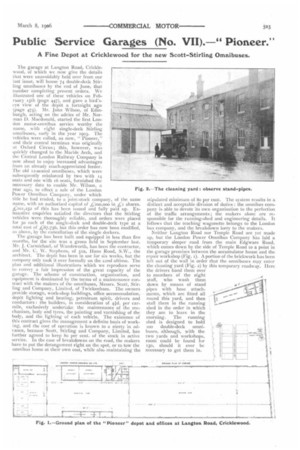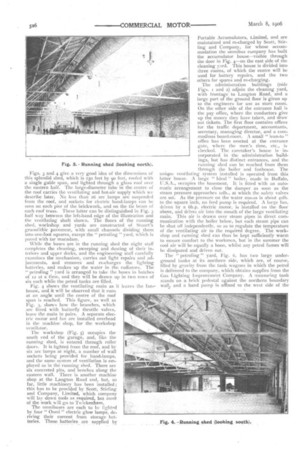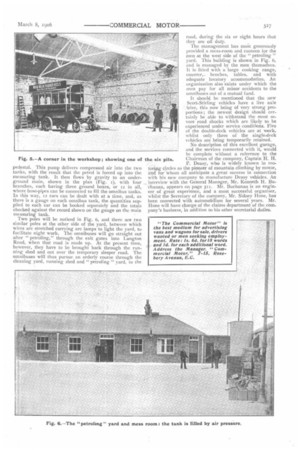Public Service Garages (No. VII).—" Pioneer.
Page 17

Page 18

Page 19

If you've noticed an error in this article please click here to report it so we can fix it.
A Fine Depot at Cricklewood for the new Scott-Stirling Omnibuses.
The garage at Langton Road, Cricklewood, of which we now give the details that were unavoidably held over from our last issue, will house 74 double-deck Stirling omnibuses by the end of June, that number completing present orders. We illustrated one of these vehicles on February isth (page 447), and gave a bird'seye view of the dep6t a fortnight ago. (page 47s). Mr. John Wilson, of Edinburgh, acting on the advice of Mr. Norman D. Macdonald, started the first London motor-omnibus service worthy the name, with eight single-deck Stirling omnibuses, early in the year 1903. The vehicles were called, as now, " Pioneer," and their central terminus was originally at Oxford Circus; this, however, was quickly changed to the Marble Arch, and the Central London Railway Company is now about to enjoy increased advantages from an already much-appreciated feeder. The old 12-seated omnibuses, which were subsequently reinforced by two with 14 seats and one with 16 seats, furnished the necessary data to enable Mr. Wilson, a year ago, to effect a sale of the London Power Omnibus Company, under which title he had traded, to a joint-stock company, of the same name, with an authorised capital of ,-,C200,000 in ,{-,1 shares. 4;101,252 of this has been issued and fully paid up. Exhaustive enquiries satisfied the directors that the Stirling vehicles were thoroughly reliable, and orders were placed for so each of the single-deck and double-deck type at a total cost of j;67,756, but this order has now been modified, as above, by the cancellation of the single deckers. The garage has been built and equipped in less than five months, for the site was a green field in September last. Mr. J. Carmichael, of Wandsworth, has been the contractor, and Mr. C. W. Stephens, of sia, Hans Road, S.W., the architect. The depot has been in use for six weeks, but the company only took it over formally on the 22 nd ultimo. The plan and additional illustrations which we reproduce serve to convey a fair impression of the great capacity of the garage. The scheme of construction, organisation, and equipment is dominated by the terms of a maintenance contract with the makers of the omnibuses, Messrs. Scott, Stirling and Company, Limited, of Twickenham. The owners provide storage, work-shop buildings, office accommodation, depot lighting and heating, petroleum spirit, drivers and conductors : the builders, in consideration of 44d. per carmile, exclusively undertake the maintenance of the mechanism, body and tyres, the painting and varnishing of the body, and the lighting of each vehicle. The existence of this contract gives the management a definite basis of working, and the cost of operation is known to a nicety in advance, because Scott, Stirling and Company, Limited, has Further agreed to keep So per cent. of the stock in active service. In the case of breakdowns on the road, the makers have to put the derangement right on the spot, or to tow the omnibus home at their own cost, while also maintaining the
stipulated minimum of So per cent. The system results in a distinct and acceptable division of duties : the omnibus company is able to devote its own organisation to the perfection of the traffic arrangements; the makers alone are responsible for the running-shed and engineering details. It follows that the teaching wagonette belongs to the London bus company, and the breakdown lorry to the makers. Neither Langton Road nor Temple Road are yet made up, but the London Power Omnibus Company has laid a temporary sleeper road from the main Edgware Road, which comes down by the side of Temple Road to a point in the garage premises between the accumulator house and the repair workshop (Fig. 1). A portion of the brickwork has been left out of the wall in order that the omnibuses may enter the cleaning yard (Fig. 2) by this temporary roadway. here the drivers hand them over to members of the night staff, who wash them down by means of stand pipes with hose attachments, which are fitted all round this yard, and then stall them in the running shed in the order in which they are to leave in the morning. The running shed is designed to hold too double-deck omnibuses, although, with the two yards and workshops, room could be found for iso, should it ever be necessary to get them in.
Figs. 3 and 4 give a very good idea of the dimensions of this splendid shed, which is 250 feet by go feet, roofed with a single gable span, and lighted through a glass roof over the eastern half. The large-diameter tube in the centre of the roof carries the ventilating and hot-air supply which we describe later. No less than 26 arc lamps are suspended from the roof, and sockets for electric hand-lamps can be seen on each pier of the brickwork, and on the tie beam of each roof truss. These latter can be distinguished in Fig. 3 half way between the left-hand edge of the illustration and the ventilating shaft shown. The floors of the running shed, workshop. and yards are constructed of Stuart's granolithic pavement, with small channels dividing them into one-foot squares, except the " petroling " yard, which is paved with tar macadam.
While the buses are in the running shed the night staff completes the cleaning, sweeping and dusting of their interiors and upper decks, and the engineering staff carefully examines the mechanism, carries out light repairs and adjustments, and removes and re-charges the lighting batteries, and makes up the water in the radiators. The " petroling " yard is arranged to take the buses in batches of 12 at a time, and they will be drawn up in two rows of six each while the petrol tanks are filled.
Fig. 4 shows the ventilating main as it leaves the fanhouse, and it will be observed that it runs at an angle until the centre of the roof span is reached. This figure, as well as Fig. 3, shows how the branches, which are lined with butterfly throttle valves, leave the main in pairs. A separate electric motor and fan are installed overhead in the machine shop, for the workshop vmtilator.
The workshop (Fig. 5) occupies the south end of the garage, and, like the running shed, is entered through roller doors. It is lighted from the roof, and by six arc lamps at night, a number of wall sockets being provided for hand-lamps, and the same system of ventilation is employed as in the running shed. There are six concreted pits, and benches along the eastern wall. There is another machine shop at the Langton Road end, but, so far, little machinery has been installed; this has to be provided by Scott, Stirling and Company, Limited, which company will lay down tools ns required, but most of the work will go to Twickenham.
The omnibuses are each to be lighted by four " Osmi " electric glow lamps, deriving their current from storage batteries. These batteries are supplied by Portable Accumulators, Limited, and are maintained and re-charged by Scott, Stirling and Company, for whose accommodation the omnibus company has built the accumulator house—visible through the door in Fig. 4—on the east side of the cleaning yard. This house is divided into three rooms, of which the centre will be used for battery repairs, and the two others for spares and re-charging.
The administration buildings (vide Figs. i and 2) adjoin the cleaning yard, with frontage to Langton Road, and a large part of the ground floor is given up to the engineers for use as store room. On the other side of the entrance hall is the pay office, where the conductors give up the money they have taken, and draw out tickets. The first floor contains offices for the traffic department, accountants, secretary, managing director, and a commodious board-room. A small " lean-to " office has been erected at the entrance gate, where the men's time, etc., is checked. The caretaker's house is • incorporated in the administration buildings, but has distinct entrances, and the running shed can be reached from them through the boiler and fanhouse. The unique ventilating system installed is operated from this latter house. A large " Ideal " boiler, made in Buffalo, U.S.A., occupies the basement. It is lilted with an automatic arrangement to close the damper as soon as the steam pressure approaches tab., at which the safety valves are set. As the pressure on the water maids is about 4olb. to the square inch, no feed pump is required. A large fan, driven by a 6h.p. electric motor, is installed on the floor above, and drives air into the mouth of the large ventilating main. This air is drawn over steam pipes in direct communication with the boiler below, but each steam pipe can be shut off independently, so as to regulate the temperature of the ventilating air to the required degree. The workshop and running shed can thus be kept sufficiently warm to ensure comfort to the workmen, but in the summer the cool air will be equally a boon, whilst any petrol fumes will be dissipated and driven out.
The " petroling" yard, Fig. 6, has two large underground tanks at its northern side, which are, of course, filled by gravity from the tank wagons in which the petrol is delivered to the company, which obtains supplies from the Gas Lighting Improvement Company. A measuring tank stands on a brick pedestal against the northern boundary wall, and a hand pump is affixed to the west side of the
pedestal. This pump delivers compressed air into the two tanks, with the result that the petrol is forced up into the measuring tank. It then flows by gravity to an underground main, shown in the plan (Fig. 1), with four branches, each having three ground boxes, or 12 in all, where hose-pipes can be connected to fill the omnibus tanks. In this way, 12 cars can be dealt with at a time, and, as there is a gauge on each omnibus tank, the quantities supplied to each car can be booked separately and the totals checked against the record shown on the gauge on the main measuring tank. Two poles will be noticed in Fig. 6, and there are two similar poles at the other side of the yard, between which wires are stretched carrying arc lamps to light the yard, to facilitate night work. The omnibuses will go straight out after " petroling," through the exit gates into Langton Road, when that road is made up. At the present time however, they have to be brought back through the running shed and out over the temporary sleeper road. The omnibuses will thus pursue an orderly course through the cleaning yard, running shed and " petrofing " yard, to the
road, during the six or eight hours that they are off duty.
The management has most generously provided a mess-room and canteen for the men at the west side of the " petroling " yard. This building is shown in Fig. 6, and is managed by the men themselves. It is fitted with a large cooking range, counter,. benches, tables, and with adequate lavatory accommodation. An organisation also exists under which the men pay for all minor accidents to the omnibuses out of a mutual fund.
It should be mentioned that the new Scott-Stirling vehicles have a live axle irive, this now being of very strong proportions; the newest design should certainly be able to withstand the most severe road shocks which are likely to be experienced under service conditions. Five of the double-deck vehicles are at work, whilst only three of the single-deck vehicles are being temporarily retained.
No description of this excellent garage, and the services connected with it, would be complete without a referenoe to the Chairman of the company, Captain H. H. P. Deasy, who is widely known in motoring circles as the pioneer of mountain climbing by motor, and for whom all anticipate a great success in connection with his new company to manufacture Deasy vehicles. An interview with the General Manager, Mr. Kenneth H. Buchanan, appears on page 511. Mr. Buchanan is an engineer of great experience, and a most successful organiser, whilst the Secretary of the company, Mr. Sidney FIone, has been connected -with autornobilism for several years. Mr. Hone will have charge of the claims department of the company's business, in addition to his other secretarial duties. pits. the six




















